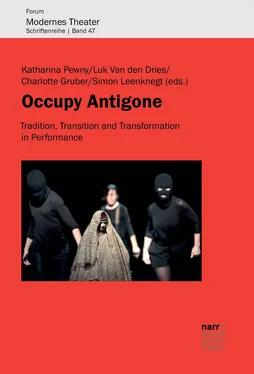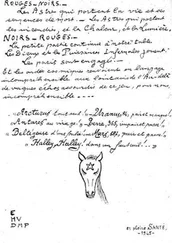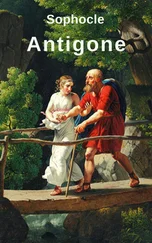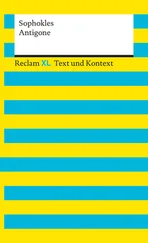In Sophocles’ Antigonethe confrontations between the positions of Antigone and Creon are obviously the most important ones. For Antigone the syllogism, with which the play begins, is: To be human means to bury our dead/kin as the gods have commanded us to do Polyneices is my (dead) brother Therefore I must (and will) bury Polyneices And for Creon, who presents his argument in the following section of the play, the syllogism has the following formulation: It is illegal to bury enemies Polyneices is an enemy of the polis It is illegal to bury Polyneices The gradually accelerating conflict between Antigone and Creon is based on the incommensurability of these two syllogistic arguments which are simultaneously contextualized in social, religious and ethical terms. Relying on divine authority both of them argue that it is either legal or illegal to bury Polyneices. It cannot be both. Such a situation was formulated by Aristotle as the Law of Non-contradiction that “P and not-P” is always false, or according to Aristotle’s own formulation in the Metaphysics: “It is impossible that the same thing can at the same time both belong and not belong to the same object and in the same respect”.8 However, just after the conflict between Antigone’s and Creon’s syllogistic formulations has challenged the Law of Non-contradiction concerning the burial of Polyneices, in the next section of the play, with the chorus singing the first stasimon, usually referred to as the "Ode to Man", this challenge to one of the basic laws of logic is further reinforced. In the "Ode to Man" the chorus directly draws attention to the contradictory nature of what it means to livea human life and to behuman. There is only one thing concerning human ‘life’ about which there is no argument, and that is that all humans are mortal which as the chorus argues cannot be prevented, even by the remarkable marvels of human inventiveness. Here is an abbreviated quote from the “Ode to Man”, which obviously needs a much more detailed philological explication. But it contains enough information to formulate its syllogistic argument, and for the moment I will insert the key concept of deinonand deinotaton, referring to the contradictory characteristics that define what it means to be human – being both wondrous and monstrous (which will be clarified in what follows) – without translation: There is much that is deinon, but nothing that surpasses man in deinotaton. He sets sail on the frothing waters amid the south winds of winter tacking through the mountains and furious chasms of the waves. […] Everywhere journeying, inexperienced and without issue, he comes to nothingness. Through no flight can he resist the one assault of death, even if he has succeeded in cleverly evading painful sickness. […] Clever indeed, mastering The ways of skill beyond all hope, he sometimes accomplishes evil, sometimes achieves brave deeds.9 The attempt to formulate the syllogistic structure of the “Ode to Man” is much more complex than in the two previous cases. First, because it consists of three universal statements – which is also an accepted form of syllogism (“All men are mortal. / All Greeks are men. / All Greeks are mortal.”) – and these universal statements in turn branch out into syllogisms about the mortality of humans that include particular statements as well as referencing particular human deeds and claims; and, secondly, (as I pointed out before) because of the preference for the use of negative statements, like "Nothing surpasses man in being deinon”. The following attempt to formulate an extended syllogism in the “Ode to Man” gives us a basic idea of this complexity, regardless of its circularity: Nothing surpasses humans (which I prefer to “man” in the quote) in being deinon; or simply: All humans are deinon Since humans “sometimes accomplish evil, / sometimes achieve brave deeds”, they are defined by their inherent contradictory nature. Or in other words: the Law of Non-contradiction does not apply to human nature or actions, i.e. what it means to be human Therefore the attempt to apply the Law of Non-contradiction to humans will show that they are deinon, possessing contradictory characteristics We could probably say that logic has outwitted itself by arguing that "The Law of Non-contradiction does not apply to human nature or actions", which is a self-referential statement, like the Cretan who says that "All Cretans are liars". The Greeks were no doubt fascinated by situations of logic and its contextualisations where the relations between inclusions and exclusions are tested and logic and language seem to turn upon themselves, as in such paradoxical statements. Classical Greek tragedy exposes and examines the tensions between different laws of logic and between these laws and the contexts of the fictional world, including those specific situations where the laws of logical thinking are actually applied but also questioned. This activates a self-referential mechanism where the paradoxical combinations of context and logic serve as a challenge to the adequacyof logical thinking for the understanding of the complexity of what it means to be human. But classical drama – and I should really only speak of Sophocles’ Antigonehere – does not challenge the fundamental validityof logical thinking as such. As I intend to show however, the two twentieth-century interpretations of Sophocles’ Antigoneby Heidegger and Brecht I will now examine more closely, also contest the validityof the traditional, Classical forms of logical thinking, in particular in those cases when the logical argumentation refers to ethical contexts, regardless if the interpretation is primarily philosophical (as with Heidegger) or performative (as in Brecht’s case). 2. Heidegger’s deinon The crucial issue for our present discussion is how to interpret the notion of deinon, which is a concept that has a broad range of meanings. The following five points give an overview of its contradictory connotations: 1 It can mean fearful, terrible, dread, dire,in Sophocles also dangeror suffering awe 2 The term projects a sense of being powerful,related to being able, clever, cunningand skilful 3 It also refers to force or power – mighty, powerful, wondrous, marvellous or strange.In his German translation from 1804, Hölderlin used " ungeheuer", which was used by Brecht in his 1948 adaptation, meaning awesome, monstrous 4 For Heidegger on the other hand it means violent, which in a strange combination with unheimisch– not homely, is the particular connotation he developed on the basis of deinonas uncanny( unheimlich) instead of ungeheuer 5 And as we shall finally see, in Brecht’s interpretation, the deinonof a human is his ability, even his fatal attraction for becoming his own enemy, which is the ultimate form of negation through annihilation One of the many occasions when Heidegger formulated his position with regard to deinonwas in a lecture course in 1935 at the University of Freiburg, where he was then the rector. These lectures were first published as An Introduction to Metaphysicsin 1953. Here Heidegger emphasized that deinonmeans the powerful in the sense of one who uses power, who not only disposes of power [ Gewalt] but is violent [ gewalt-tätig] insofar as the use of power is the basic trait not only of his action but also of his being-there [ Dasein]. Here we use the word violence in an essential sense extending beyond the common usage of the word, as mere arbitrary brutality. In this common usage violence is seen from the standpoint of a realm which draws its standards from conventional compromise and mutual aid, and which accordingly disparages all violence as a disturbance of the peace. […] Man is deinon, first because he remains exposed within this overpowering power, […] But at the same time man is deinonbecause he is the violent one […] he gathers the power and brings it to manifestness.
Читать дальше










